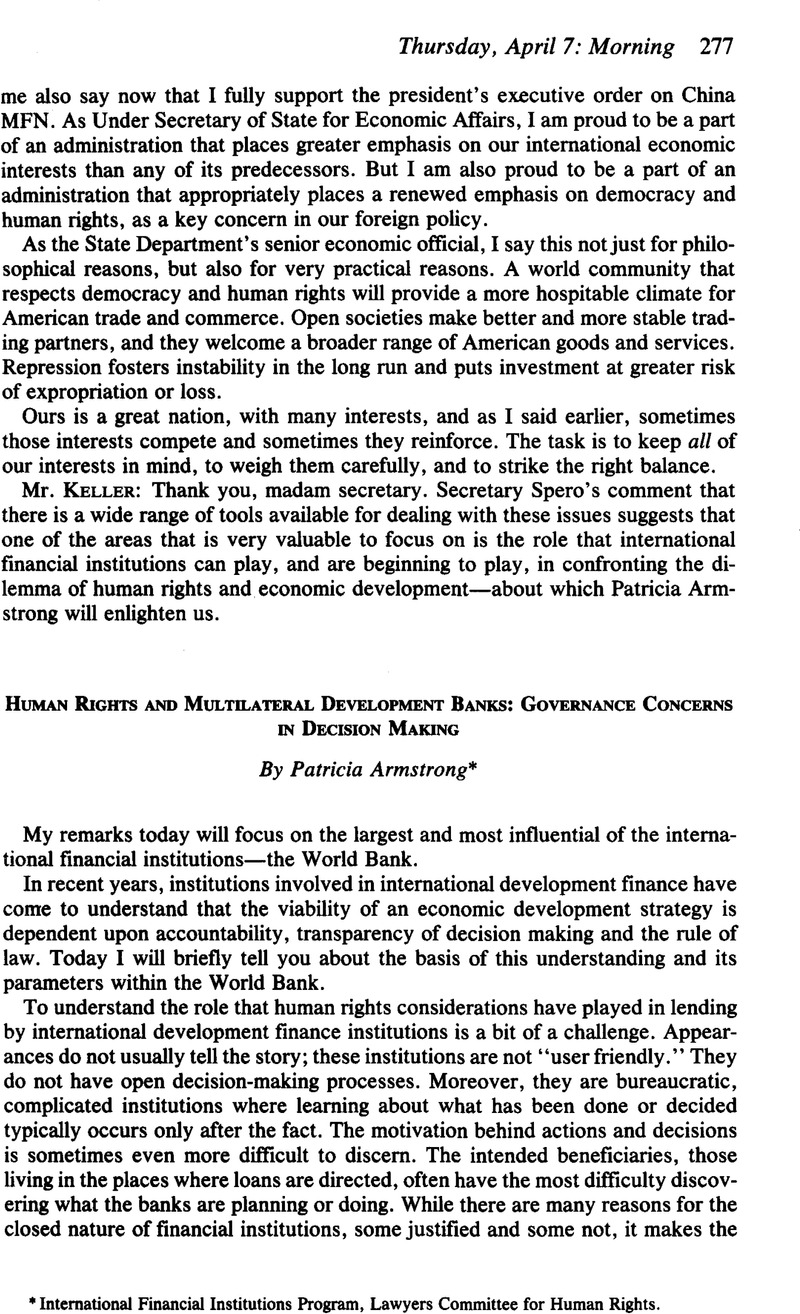Article contents
Human Rights and Multilateral Development Banks: Governance Concerns in Decision Making
Published online by Cambridge University Press: 28 February 2017
Abstract

- Type
- Human Rights, Multinational Business and International Financial Institution
- Information
- Copyright
- Copyright © American Society of International Law 1994
References
1 Articles of Agreement of the International Bank for Reconstruction and Development, opened for signature, Dec. 27, 1945, 60 Stat. 1440 (1946), HAS No. 1502, 2 UNTS 134, as amended Dec. 16, 1965, 16 UST 1942, TIAS No. 5929, art. IV, § 10, [hereinafter IBRD Charter]. Similar provisions are also found in the charters of the International Development Association (art. V, § 6); International Finance Corporation (art. Ill, § 9); Inter-American Development Bank (art. V, § 6); African Development Bank (art. XXXVIII, ¶ 2); and Asian Development Bank (art. 36, ¶ 2).
2 Agreement Establishing the European Bank for Reconstruction and Development, May 29,1990, art 1. The preamble to the agreement explicitly mentions the importance of the Rule of Law and respect for human rights. Soon after the EBRD became operational in 1991, its Board adopted “Procedures to Implement the Political Aspects of the Mandate of the European Bank for Reconstruction and Development,” which outlines suggested procedures for the implementation of the Bank’s mandate. Among the factors cited as important are representative government, independent judiciaries, equal protection under the law, fair criminal procedures and freedom of speech. See 29 ILM 1077 (1990).
3 International Financial Institutions Act, § 701 (a)(1), 22 U.S.C. § 262d (a)(l)(1994).
4 IBRD Charter, art. IV, § 10 and art. V, § 5(c). The Bank’s legal department concluded that the charter provisions applied with full force to executive directors, but that there was no legal sanction available to challenge a vote by an executive director motivated by political considerations. Ibrahim F. I. Shihata, “The World Bank and Human Rights: An analysis of Legal Issues and the Record of Achievements,” (paper prepared for the International Third World Legal Studies Association, Miami, Florida, Jan. 8, 1988), at 11.
5 World Bank, Sub-Saharan Africa�From Crisis To Sustainable Growth 60 (1989).
6 Id. at 60-61.
7 Memorandum of the Vice President and General Counsel, “Issues of ‘Governance’ in Borrowing Members—The Extent of Their Relevance Under the Bank’s Articles of Agreement” (Dec. 21,1990), at 2.
8 Id. at 2-3.
9 Id. at 36. The relevance of political instability to the Bank’s work has not been in dispute: “The Bank and its affiliates are forbidden by their Articles of Agreement to act from political motives, but the Bank Group cannot ignore conditions of obvious internal political instability or uncertainty which may directly affect the economic prospects of a borrower. To this extent, therefore, a country’s political situation is taken into account in the investigation of proposals for financing.” World Bank, Policies And Operations 43 (1974), cited in Mamorstein, Victoria E., World Bank Power to Consider Human Rights Factors in Loan Decisions , 13 J. Int’l Law & Econ. 113, 128 (1978)Google Scholar.
10 In contrast, the Bank views the promotion of economic and social rights, embodied in its strategy to reduce poverty, as its overarching objective. See, e.g., the World Bank’s contribution to the 1993 World Conference on Human Rights: The World Bank And The Promotion Of Human Rights, UN Doc. A/CoNF.157/PC/61/Add.l9 (1993).
11 World Bank, Managing Development: The Governance Dimension (Aug. 29, 1991). A version of this discussion paper was published in 1992 by the Bank under the title Governance and Development [hereinafter Governance and Development
12 World Bank, Governance: The World Bank’s Experience (Operations Policy Department, Final Draft) (Nov. 23, 1993) [hereinafter Governance Experience]. (A version of this paper is expected to be published in 1994.)
13 Id. at 1. See also Governance and Development, supra note 11, at 9
14 Id. at 39
15 Governance Experience, supra note 12, at 38.
16 Governance and Development, supra note 11, at 30.
17 Id. The discussion paper from which Governance and Development was drawn stated: “From the Bank’s point of view, the rule of law is not an end in itself; it is only to the extent that it establishes a set of preconditions for development that it comes within the purview of the Bank.” Governance and Development, supra note 11, at 10-11.
18 Governance and Development, supra note 11, at 31-39.
19 Governance Experience, supra note 12, at 1, n. 2.
20 Governance and Development, supra note 11, at 47.
21 Governance Experience, supra note 12.
22 Id. at 35-37.
23 World Bank: Viet Nam, Transition To The Market: An Economic Report 34 (Report No. 11902 VN, Sept. 15, 1993).
24 Id. at 41.
- 5
- Cited by




